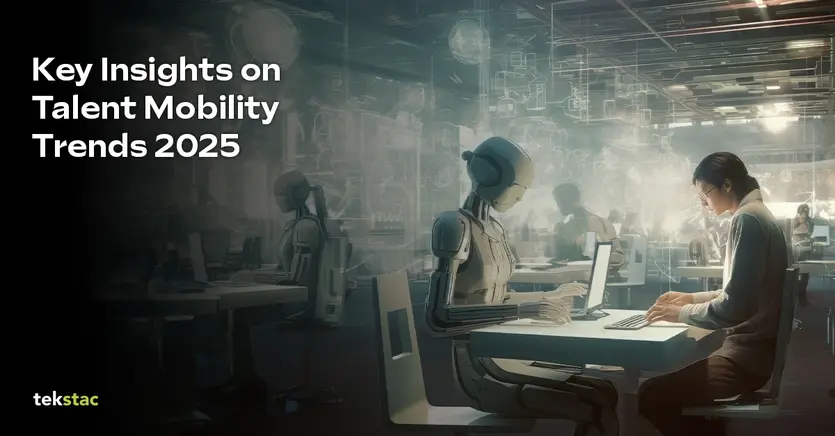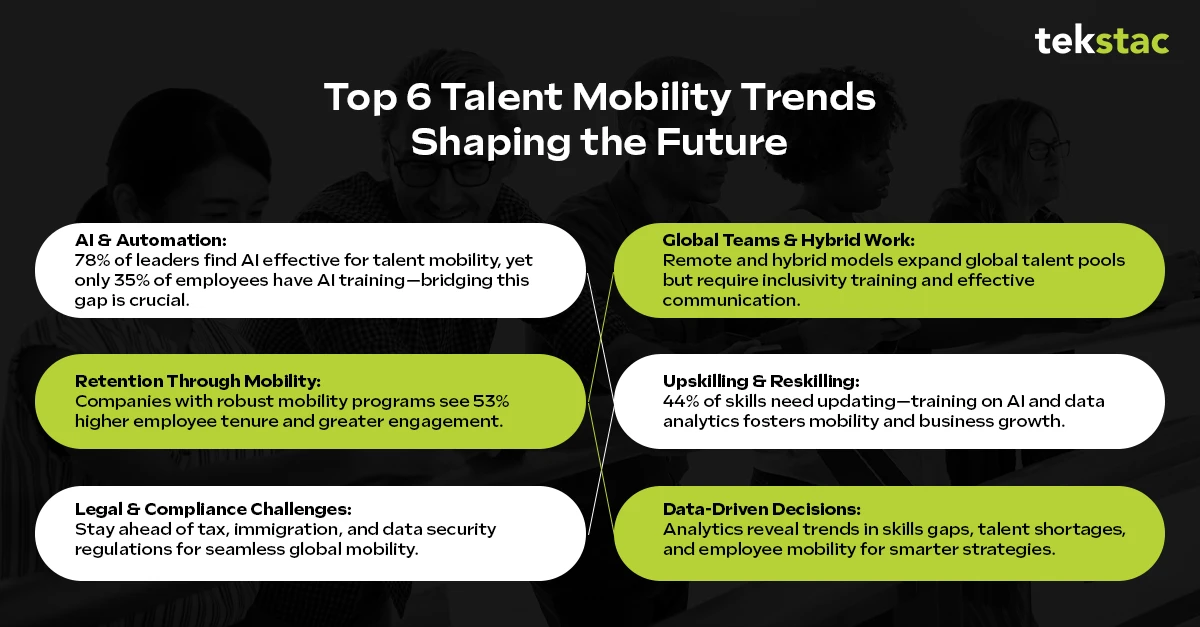Talent Mobility Trends in 2025: What Companies Need to Know

Key Talent Mobility Trends Shaping 2025
There’s plenty for leaders to consider as businesses continue to recover from the pandemic, grapple with the impacts of AI, and navigate a changing workforce with more global and hybrid work than ever—not to mention a need to achieve more with fewer resources. How do you determine where to focus your 2025 strategies? Moreover, how can you ensure you’re able to not only accomplish business goals but also grow employee retention and development?
The answer is a strong talent mobility strategy, and there are several trends to be aware of for 2025.
This next year continues the widespread recovery from the impacts of the COVID-19 pandemic, bringing a renewed focus on workforce strategy and the challenges and benefits of both remote and on-site work. An increasingly global workforce also means more opportunity for employees to change not only their role, but their location.
As AI gains traction, it changes both how companies operate and the work—or upskilling—required of employees. Reliance on AI can save costs and address some talent shortages, but won’t solve all economic challenges faced by companies.
These challenges can all be addressed by a robust talent mobility strategy. Read on to dive into the top six talent mobility trends to watch in 2025.
What is Talent Mobility?
First, it’s helpful to understand talent mobility. Talent mobility, or internal mobility, refers to the movement of workers across an organization, whether that’s between roles, departments, or locations. Typically, such mobility serves to achieve strategic objectives while also offering growth and development opportunities to employees.
Top 6 Talent Mobility Trends That Will Define the Future

1. AI and Automation
In recent years, AI has shown an ability to match employees with opportunities, with two thirds of leaders making investments in this area and 78% finding AI effective at identifying talent mobility opportunities.
Beyond simply identifying opportunities, the advancement of AI has also opened up new roles for employees who want to grow their AI skills. Although three quarters of companies are adopting AI, just 35% of employees have received AI training. This is a huge opportunity for companies looking to improve mobility.
At the same time, AI can reduce the need for human workers, forcing some employees into mobility they may not have sought on their own. Per the World Economic Forum, future advancements in technology could eliminate 83 million jobs, meaning these workers must pivot into something new.
2. Global Teams and Hybrid Work
When the pandemic thrust employees across the globe into remote work, companies were unprepared for this shift in working styles. Over time, however, many businesses have realized the benefits of a hybrid or remote model.
Not only does global and hybrid expand the talent pool by allowing companies to hire across the world, but building global teams opens up new opportunities to employees who may be interested in relocating.
However, there are challenges to managing global and hybrid organizations, so you must understand how to foster inclusivity and engagement. Train your teams on cultural differences to enable stronger partnership across geographies. Keep time zones in mind when scheduling meetings and deadlines, and focus on transparent communication to keep employees aware of all changes and updates.
3. Talent Mobility as a Retention Strategy
A major benefit of talent mobility is its ability to increase employee retention. For instance, 64% of workers surveyed said that the opportunity to take on international assignments would encourage them to stay in their roles.
But mobility doesn’t have to be cross-continental to be impactful for retention. Companies with plenty of talent mobility options see 53% higher tenures as compared to those without. When employees feel they’re provided with ample opportunities for growth and development, they’re more likely to stay with the organization.
Only a third of organizations have a formal mobility program, but if you’re ready to create a strategy, consider investing in internal job marketplaces (or AI-driven matching), detailed career ladders and pathways, and training opportunities.
4. Upskilling and Reskilling
Nearly two thirds of company leaders report an increasing skills gap among employees, which negatively impacts mobility options. In other words, the ability for employees to move within the company relies upon training and skills development.
And the important skills are evolving—according to the World Economic Forum, an average of 44% of individuals’ skills will need to change, with more priorities placed on skills like AI, data analytics, and other systematic and technological knowledge.
Giving employees a chance to gain new skills will open up mobility opportunities while also meeting key business objectives. Assess the critical skills your teams may be missing, then consider developing internal training opportunities or partnering with skilling platforms or systems. Tekstac, for instance, provides an end-to-end platform to help your team develop and improve their skills.
It will pay off: companies with strong talent mobility programs not only see higher retention, but also 79% more employee promotions to leadership.
5. New Legal and Compliance Challenges
More and more, companies must stay abreast of ongoing changes to global mobility, tax, and immigration regulations. While there are several benefits to global mobility, these employees may trigger tax liabilities or risks companies must be aware of and compliant with.
Additionally, employment law varies across jurisdictions, which requires continued awareness of contract laws, pay and hour requirements, and worker classifications.
Plus, requirements for work visas and permits differ by country, with some countries being easier to move between than others. Staying informed of these details will be critical to a strong mobility strategy.
Finally, you’ll need to understand regional data privacy and security regulations and ensure compliance.
6. Data-Driven Decision Making
Leveraging data analytics to discover market trends, employee needs, mobility patterns, and other information can change the game for your talent mobility strategy.
Rather than relying on anecdotal details, use advanced analytics to see exactly where your teams need to upskill or retrain. At the same time, you can assess past mobility trends, like movement between departments or levels. Combined with employee performance data and business objectives, you can even institute customized mobility options.
Plus, leaders can use data insights to understand trends like talent shortages, skills gap, or global talent maps, which make it easier to decide who to hire and where to hire them.
A robust analytics platform can centralize this data and provide dashboards and visualizations that help you make critical decisions.
What Is the Future of Talent Mobility?
Start the new year off right with a renewed focus on talent mobility. Not only does this improve your employee experience and lead to higher retention, it also gives you a chance to upskill your teams and achieve critical objectives while staying on top of technological advancements.
Be sure to stay informed of changing laws around data privacy, immigration, and employment, and keep an eye on areas your teams could use new skill sets.
For the best shot at growing your teams’ skills and offering increased mobility, you want a platform like Tekstac. With over 500+ learning paths, hands-on practice labs, and comprehensive assessments, you can upskill your team, accelerate talent mobility, and set your employees up for success. See how our platform enhances talent mobility.
Leverage Tekstac’s 360° skilling platform to boost internal mobility, enhance retention, close skill gaps, and cut hiring costs.





